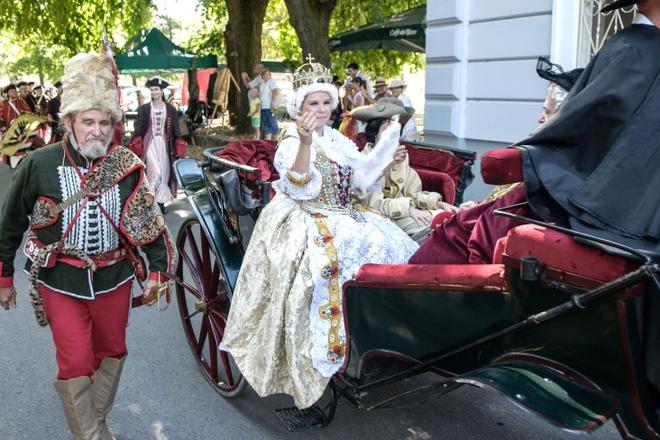On August 29, Maria Theresa, Austro-Hungarian Empress, arrived at the municipality of Mojmírovce (or at least her lookalike did). The empress entered the town, in the Nitra district, the hometown of her favourite companion Count Grassalkovich, with an elite entourage made up of a regiment from Karlovac and the feared hussars of Baron František Trenck.
Maria Theresa’s appearance in Mojmírovce is part of a bigger historical festival called Maria Theresa in Baroque Garden. It is a loose sequel of last year’s project In the Footsteps of Grassalkovich, the goal of which was to use important personalities from Slovakia’s history to make some localities in the Váh-Danube-Ipeľ Euro-region (all three are Slovak rivers) more attractive to tourists.
Last year, Maria Theresa came accompanied by Count Anton Grassalkovich and Count Imrich Hunyady while, this year, she was escorted by the glorious troops of the Austro-Hungarian monarchy. The empress, wearing a detailed historical replica of her true coronation outfit, spent an afternoon in the park of Mojmírovce mansion, Daniel Balko, head of the Regional Association Váh-Danube-Ipľ (Váh-Dunaj-Ipeľ) which organises the event, told the TASR newswire.
The event transformed the local mansion complex into a noble Baroque garden with a host of period attractions. Visitors were able to visit the bower to have a cup of coffee with Maria Theresa and take a photo with her, taste ottoman delicacies served by Oriental servants in the Ottoman tent, and watch Oriental dancers perform. In the military camp, visitors could watch the military training of the regiment from Karlovac (a central-Croatian city which used to belong to the Austro-Hungarian empire) and even take part in a true-to-life military recruitment. The festival also included a concert of Baroque music, demonstrations of Baroque dances, short drama scenes, military fights and duels, knights’ tournaments for children, Turkish coffee-tasting, and water pipes, as well as expert lectures on the Baroque countryside near the Czech castle of Kuks and Baroque monuments in the Nitra region, Balko said. In the courtyard, period craftsmen set up stalls, and children and adults played games, including an ancient game called picík. The day ended with a fire-show.


 (source: TASR)
(source: TASR)